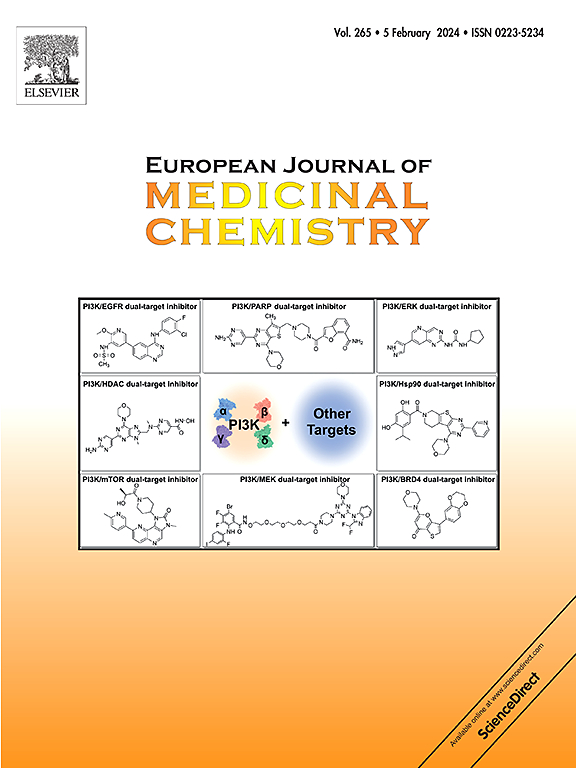用于鉴定霍诺喹分子靶点的化学探针
IF 5.9
2区 医学
Q1 CHEMISTRY, MEDICINAL
引用次数: 0
摘要
红没药醇是一种天然产物,具有一系列有趣的生物效应,包括显著的抗肿瘤特性。然而,由于它的药代动力学特性一般,而且缺乏合成方法来获得具有更好特性的专门设计的衍生物,因此阻碍了对其治疗潜力的充分发掘。此外,人们对 honokiol 的特定分子靶点仍然知之甚少,这也限制了为后续优化计划寻找替代靶点。在这项工作中,我们描述了一系列优化的合成路线,这些路线允许获得各种霍诺克醇衍生物,其中包括一套用于绘制活细胞中潜在蛋白质靶标的最小光亲和探针。对最有效的探针进行的化学蛋白质组学研究显示,一组确定的蛋白质是霍诺克醇的细胞靶标。值得注意的是,多达62%的已鉴定蛋白质都描述了在癌症中的作用,凸显了它们与honokiol抗肿瘤作用的潜在关系。此外,通过细胞热转移分析法(CETSA),几种最热门的蛋白质已被验证为与 honokiol 的直接结合伙伴。总之,本文所描述的工作首次揭示了活细胞中霍诺基醇的细胞靶标,并有助于确定受这种天然产物影响的特定分子通路。本文章由计算机程序翻译,如有差异,请以英文原文为准。


Chemical probes for the identification of the molecular targets of honokiol
Honokiol is a natural product with an interesting array of biological effects, including significant anti-tumor properties. However, full exploration of its therapeutic potential is hampered by its modest pharmacokinetic profile and by the lack of synthetic methods that allow to obtain specifically designed derivatives with improved properties. In addition, the specific molecular targets of honokiol remain poorly understood, a fact that limits the search of alternative hits for subsequent optimization programs. In this work we describe an optimized series of synthetic routes that allow to access to a variety of honokiol derivatives, including a set of minimalist photoaffinity probes to map potential protein targets in live cells. Chemical proteomic studies of the most potent probe revealed a defined set of proteins as the cellular targets of honokiol. Significantly, up to the 62 % of the identified proteins have described roles in cancer, highlighting their potential relationship with the antitumor effects of honokiol. Furthermore, several of the top hits have been validated as direct binding partners of honokiol by cellular thermal shift assay (CETSA). In sum, the work described herein provides the first landscape of the cellular targets of honokiol in living cells and contributes to define the specific molecular pathways affected by this natural product.
求助全文
通过发布文献求助,成功后即可免费获取论文全文。
去求助
来源期刊
CiteScore
11.70
自引率
9.00%
发文量
863
审稿时长
29 days
期刊介绍:
The European Journal of Medicinal Chemistry is a global journal that publishes studies on all aspects of medicinal chemistry. It provides a medium for publication of original papers and also welcomes critical review papers.
A typical paper would report on the organic synthesis, characterization and pharmacological evaluation of compounds. Other topics of interest are drug design, QSAR, molecular modeling, drug-receptor interactions, molecular aspects of drug metabolism, prodrug synthesis and drug targeting. The journal expects manuscripts to present the rational for a study, provide insight into the design of compounds or understanding of mechanism, or clarify the targets.

 求助内容:
求助内容: 应助结果提醒方式:
应助结果提醒方式:


